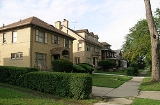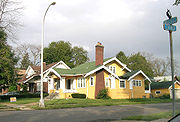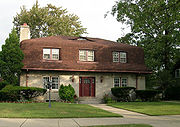
Medbury's-Grove Lawn Subdivisions Historic District
Encyclopedia
Medbury's-Grove Lawn Subdivisions Historic District is a residential historic district
located in Highland Park, Michigan
. It runs along three east-west streets: Eason Street, Moss Street, and Putitan Street, from Hamilton Avenue on the west to Woodward Avenue on the east. The district was listed on the National Register of Historic Places
in 1988.


 The Medbury's-Grove Lawn Subdivisions Historic District is a residential neighborhood of single-family, detached homes. There are 272 homes located within the district, with 251 of them classified as contributing to the district's historic character.
The Medbury's-Grove Lawn Subdivisions Historic District is a residential neighborhood of single-family, detached homes. There are 272 homes located within the district, with 251 of them classified as contributing to the district's historic character.
The neighborhood was built up primarily in the 1910s and 1920s, and features a variety of architectural styles that were popular at the time. Bungalow
s and bungalow-style houses with Craftsman
or colonial details predominate, and, in fact, the neighborhood is significant for containing Michigan's most outstanding collection of single-family bungalows and bungalow-style homes. However, foursquare
, colonial revival, and English cottage homes are also present within the neighborhood. The homes in the district are notable for their variety and the level of craftsmanship and detailing, and are excellent examples of the variety found in American suburban domestic architecture of the period 1900-1930.
The district also contains 272 garages and sheds, located along alleys behind the homes. Of these, 250 appear to date from the neighborhood's original development, and reflect the upwardly-mobile, middle-class character of the neighborhood.
Historic district (United States)
In the United States, a historic district is a group of buildings, properties, or sites that have been designated by one of several entities on different levels as historically or architecturally significant. Buildings, structures, objects and sites within a historic district are normally divided...
located in Highland Park, Michigan
Highland Park, Michigan
- Geography :According to the United States Census Bureau, the city has a total area of , all land.- Demographics :As of the census of 2000, there were 16,746 people, 6,199 households, and 3,521 families residing in the city. The population density was 5,622.9 per square mile . There were 7,249...
. It runs along three east-west streets: Eason Street, Moss Street, and Putitan Street, from Hamilton Avenue on the west to Woodward Avenue on the east. The district was listed on the National Register of Historic Places
National Register of Historic Places
The National Register of Historic Places is the United States government's official list of districts, sites, buildings, structures, and objects deemed worthy of preservation...
in 1988.
Description



The neighborhood was built up primarily in the 1910s and 1920s, and features a variety of architectural styles that were popular at the time. Bungalow
Bungalow
A bungalow is a type of house, with varying meanings across the world. Common features to many of these definitions include being detached, low-rise , and the use of verandahs...
s and bungalow-style houses with Craftsman
Arts and Crafts movement
Arts and Crafts was an international design philosophy that originated in England and flourished between 1860 and 1910 , continuing its influence until the 1930s...
or colonial details predominate, and, in fact, the neighborhood is significant for containing Michigan's most outstanding collection of single-family bungalows and bungalow-style homes. However, foursquare
American Foursquare
The American Foursquare or American Four Square is an American house style popular from the mid-1890s to the late 1930s. A reaction to the ornate and mass produced elements of the Victorian and other Revival styles popular throughout the last half of the 19th century, the American Foursquare was...
, colonial revival, and English cottage homes are also present within the neighborhood. The homes in the district are notable for their variety and the level of craftsmanship and detailing, and are excellent examples of the variety found in American suburban domestic architecture of the period 1900-1930.
The district also contains 272 garages and sheds, located along alleys behind the homes. Of these, 250 appear to date from the neighborhood's original development, and reflect the upwardly-mobile, middle-class character of the neighborhood.

